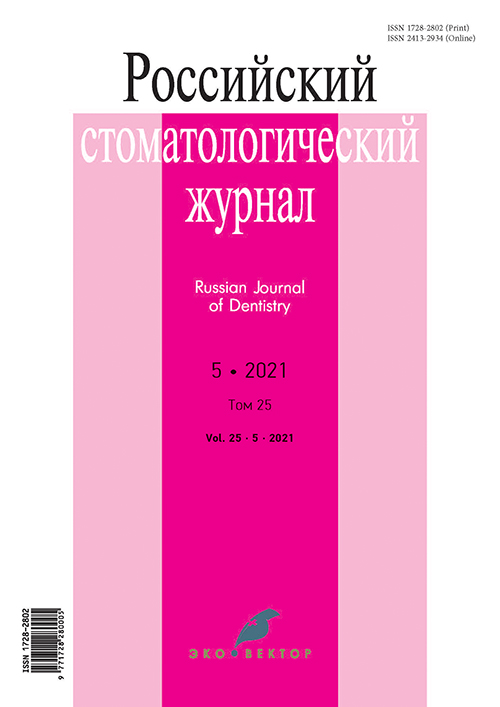Comparative analysis of dental micromobility at the stages of orthodontic dental protrusion treatment in patients with healthy periodontium and generalized periodontitis of moderate severity
- Authors: Evnevich K.A.1
-
Affiliations:
- Smolensk State Medical University
- Issue: Vol 25, No 5 (2021)
- Pages: 415-421
- Section: Clinical Investigations
- Submitted: 04.07.2022
- Accepted: 04.07.2022
- Published: 15.09.2021
- URL: https://rjdentistry.com/1728-2802/article/view/109166
- DOI: https://doi.org/10.17816/1728-2802-2021-25-5-415-421
- ID: 109166
Cite item
Abstract
BACKGROUND: Literature data revealed that the prevalence of periodontal diseases in all age groups is high, at 90%–95%. The inflammatory processes in the periodontal tissues have a multifactorial nature. The application of a small force while correcting dentofacial anomalies and deformities is necessary to achieve the desired results and to preserve physiological processes in the periodontium in case of bone resorption and alveolar process bone formation at the stages of correction.
AIM: To assess dental mobility dynamics according to periotestometry data in patients with chronic generalized periodontitis of moderate severity and protrusion of the anterior teeth at the stages of orthodontic treatment.
MATERIAL AND METHODS: A total of 70 patients aged 35–44 years with generalized periodontitis of moderate severity, complete dentition, absence of orthopedic structures, and protrusion of incisors without general somatic diseases were examined and treated. Dental micromobility was assessed using the “periotest” apparatus prior to orthodontic treatment, at the stage of eliminating gaps and after removing the bracket system.
RESULTS: The dental micromobility increased after the application of the braces, but in group 2 with generalized periodontitis of moderate severity, it was by 2.67 times higher. Anterior teeth position stabilization lead to a gradual decrease (stabilization) in periotestometry indicators. In group 2 “b” using a low-force traction, this process was more intensive.
CONCLUSION: The dynamics of periotestometry indicators at the stages of orthodontic treatment of dental protrusion in the presence of generalized periodontitis of moderate severity indicates the formation of favorable conditions in the periodontium for the mobility of the teeth using low-force traction.
Full Text
About the authors
Kirill A. Evnevich
Smolensk State Medical University
Author for correspondence.
Email: evnevich.stom@mail.ru
ORCID iD: 0000-0002-5389-7830
аssistant
Russian Federation, 50 Kirova str., 214019, SmolenskReferences
- Maksimovskii YM. Kachestvo zhizni i povedencheskie faktory riska patsientov s patologiei polosti rta i chelyustno-litsevoi oblasti. Stomatologiya dlya vsekh. 2013;(4):34–36. (In Russ).
- Grudyanov AI, Isadzhanyan KE, Apkhadze AR, et al. Comparative study of bacterial flora in patients with chronic periodontal disease assessed by various microbiological methods (preliminary study). Stomatologiya. 2014;93(5):28–31. (In Russ).
- Grudyanov AI. Collagen type I and III ratio in patients with chronic and aggressive periodontitis. Stomatologiya dlya vsekh. 2017;(4):26–31. (In Russ).
- Ermol’ev SN, Belousova MA. The status of the functional occlusion and masticatory muscles in orthodontic treatment retention phase. Stomatologiya dlya vsekh. 2018;(1):52–55. (In Russ).
- Taani DQ, Habashneh R, Hammad MM, Batieha A. The periodontal status of pregnant women and its relationship with socio-demographic and clinical variables. J Oral Rehabil. 2003;30(4):440–445. doi: 10.1046/j.1365-2842.2003.01058.x
- Kalamkarov AE, Kostin IO. Nature of distribution the occlusion of loadings in bone fabric at orthopedic treatment of patients with total loss of teeth with use the dental implants. Stomatologiya dlya vsekh. 2014;(3):27–29. (In Russ).
- Maino BG, Bednar J, Pagin P, Mura P. The spider screw for skeletal anchorage. J Clin Orthod. 2003;37(2):90–97.
- Faerovig E, Zachrisson BU. Effects of mandibular incisor extraction on anterior occlusion in adults with Class III malocclusion and reduced overbite. Am J Orthod Dentofacial Orthop. 1999;115(2):113–124. doi: 10.1016/s0889-5406(99)70337-9
- Chernyavskaya MV, Sarkarat MR. Opyt primeneniya breket-sistemy Damon dlya povysheniya kachestva ortodonticheskogo lecheniya patsientov s zubochelyustnymi anomaliyami. Sovremennaya stomatologiya. 2014;(1):67–70. (In Russ).
- Krishnan V, Davidovitch Z. Cellular, molecular, and tissue-level reactions to orthodontic force. Am J Orthod Dentofacial Orthop. 2006;129(4):469 e461–432. doi: 10.1016/j.ajodo.2005.10.007
- Zachrisson BU. Clinical outcome with mandibular second versus first premolar extractions in orthodontic treatment. World J Orthod. 2005;6(3):296–303.
- Lassila V. Effect of occlusal disorder on the gingiva in rats with experimental arteriosclerosis. Enzyme histochemical and biochemical study. Acta Odontol Scand. 1982;40(6):443–449. doi: 10.3109/00016358209025119
- Honn M, Dietz K, Godt A, Goz G. Perceived relative attractiveness of facial profiles with varying degrees of skeletal anomalies. J Orofac Orthop. 2005;66(3):187–196. doi: 10.1007/s00056-005-0445-0
- Sarikaya B, Aydin HM. Collagen/Beta-Tricalcium Phosphate Based Synthetic Bone Grafts via Dehydrothermal Processing. Biomed Res Int. 2015;2015:576532. doi: 10.1155/2015/576532
- Fiorelli G, Melsen B, Modica C. Differentiated orthodontic mechanics for dental midline correction. J Clin Orthod. 2001;35(4):239–244.
- Proffit WR. Sovremennaya ortodontiya. Persin LS, editor. Moscow: MEDpress-inform; 2019. (In Russ).
- Spitsyna OB, Trezubov VN, Trezubov VV, Volkovoi OA. Development of criteria and levels of assessment of quality of orthodontic treatment. The dental Institute. 2017;(1):54–55. (In Russ).
- Rateitschak KH. Color atlas of dental medicine. Periodontology. 3 rd revised and expanded ed. Thieme; 2005.
- Gyawali R, Bhattarai B. Orthodontic Management in Aggressive Periodontitis. Int Sch Res Notices. 2017;2017:8098154. doi: 10.1155/2017/8098154
- Denisova YL. Modern orthodontic actions in complex treatment of gingiva recession at the patients with malocclusion. Parodontologiya. 2008;(4):74–79. (In Russ).
- Zasciurinskiene E, Baseviciene N, Lindsten R, et al. Orthodontic treatment simultaneous to or after periodontal cause-related treatment in periodontitis susceptible patients. Part I: Clinical outcome. A randomized clinical trial. J Clin Periodontol. 2018;45(2):213–224. doi: 10.1111/jcpe.12835
- Pakalns GY, Flis PS, Omel’chuk NA, Rashchenko IA. Ortodontiya: uchebnik. Moscow; 2008. (In Russ).
- Akin E, Gurton AU, Sagdic D. Effects of a segmented removable appliance in molar distalization. Eur J Orthod. 2006;28(1):65–73. doi: 10.1093/ejo/cji078
- Bergamo AZN, Nelson-Filho P, Andrucioli MCD, et al. Microbial complexes levels in conventional and self-ligating brackets. Clin Oral Investig. 2017;21(4):1037–1046. doi: 10.1007/s00784-016-1865-5
Supplementary files








